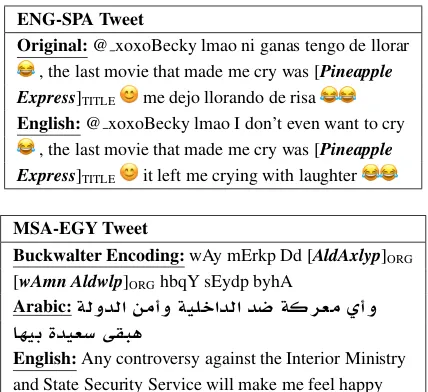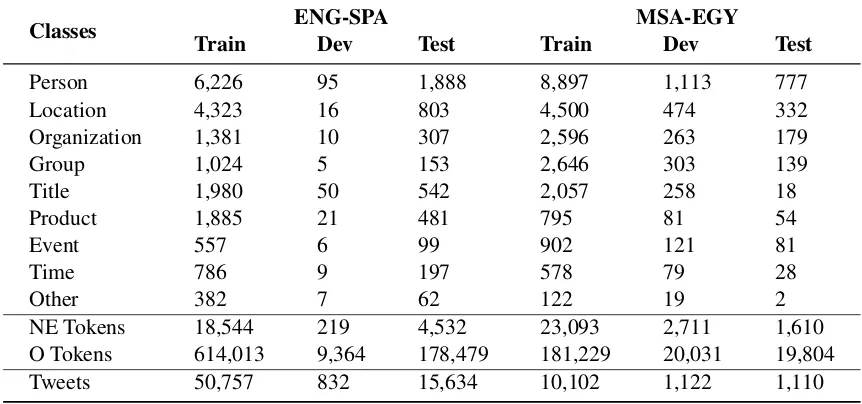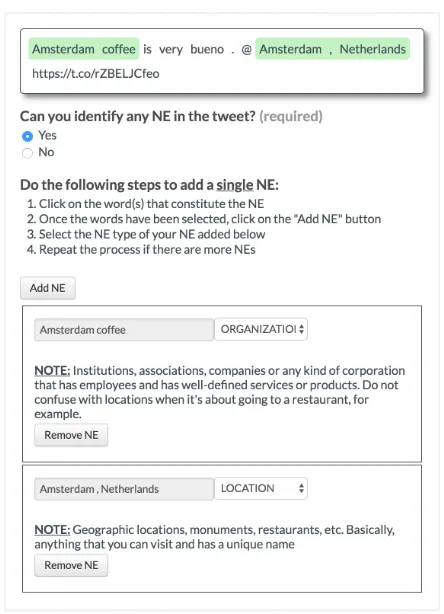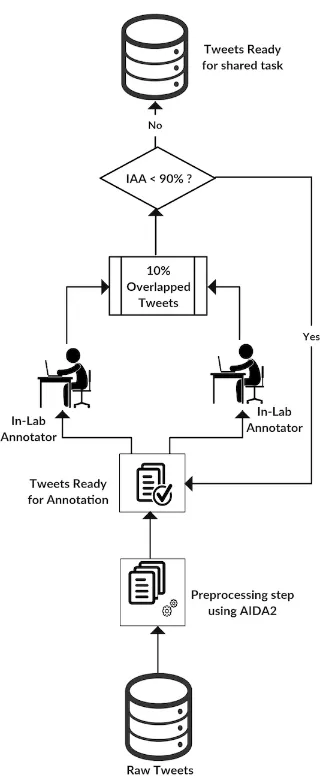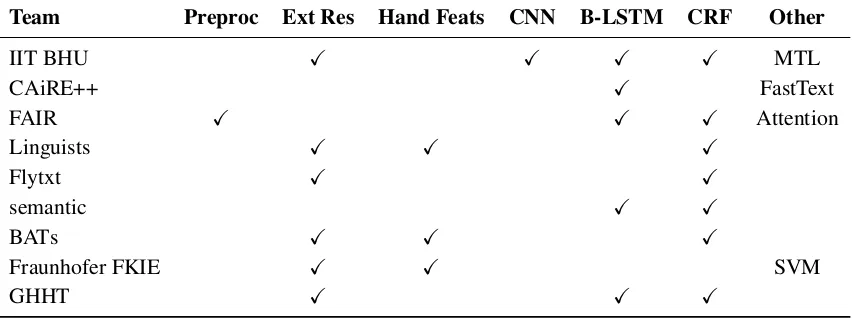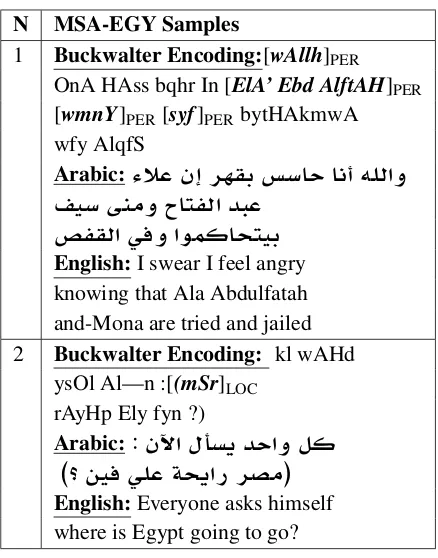138
Named Entity Recognition on Code-Switched Data:
Overview of the CALCS 2018 Shared Task
Gustavo Aguilar‡, Fahad AlGhamdi, Victor Soto†, Mona Diab, Julia Hirschberg,† and Thamar Solorio‡ Department of Computer Science, The George Washington University
{fghamdi, mtdiab}@gwu.edu
‡Department of Computer Science, University of Houston ‡{gaguilaralas, tsolorio}@uh.edu †Department of Computer Science, Columbia University
†{vs2411, julia}@cs.columbia.edu
Abstract
In the third shared task of the Compu-tational Approaches to Linguistic Code-Switching (CALCS) workshop, we fo-cus on Named Entity Recognition (NER) on code-switched social-media data. We divide the shared task into two com-petitions based on the English-Spanish (ENG-SPA) and Modern Standard Arabic-Egyptian (MSA-EGY) language pairs. We use Twitter data and 9 entity types to estab-lish a new dataset for code-switched NER benchmarks. In addition to the CS phe-nomenon, the diversity of the entities and the social media challenges make the task considerably hard to process. As a re-sult, the best scores of the competitions are 63.76% and 71.61% for ENG-SPA and MSA-EGY, respectively. We present the scores of 9 participants and discuss the most common challenges among submis-sions.
1 Introduction
Code-switching (CS) is a linguistic behavior that occurs on spoken and written language. CS hap-pens when multilingual speakers move back and forth from one language to another in the same discourse. The growing incidence of social media in the way we communicate has also increased the occurrences of code-switching on informal written language. As a result, there is a prevalent demand for more tools and resources that can help to pro-cess such phenomenon.
In the previous versions of the Computa-tional Approaches to Linguistic Code-Switching (CALCS) workshop, we focused on providing an annotated corpora for language identification (Solorio et al.,2014;Molina et al.,2016). In this
occasion, we extend the annotations to the Named Entity Recognition (NER) level. The goal of this shared task is to provide a code-switched NER dataset that can help to benchmark NER state-of-the-art approaches. This will directly impact the performance of higher-level NLP applications where the code-switching behavior is commonly found.
ENG-SPA Tweet
Original:@ xoxoBecky lmao ni ganas tengo de llorar , the last movie that made me cry was [Pineapple Express]TITLE me dejo llorando de risa
English:@ xoxoBecky lmao I don’t even want to cry , the last movie that made me cry was [Pineapple Express]TITLE it left me crying with laughter
MSA-EGY Tweet
Buckwalter Encoding:wAy mErkp Dd [AldAxlyp]ORG
[wAmn Aldwlp]ORGhbqY sEydp byhA
Arabic:T¤d ¤ Tyl d dR Tr` ©¤ Ahy dy`F Yqb¡
[image:1.595.313.527.338.534.2]English:Any controversy against the Interior Ministry and State Security Service will make me feel happy
Figure 1: Examples of the CALCS 2018 dataset. In the English-Spanish data, the highlighted words represent a movie, tagged as TITLE. While in the MSA-EGY data, the bolded words represent gov-ernment agencies, tagged as ORGANIZATION
We had a total of 9 participants from which we received 8 submissions on English-Spanish and 5 submissions on Modern Standard Arabic-Egyptian. The best F1-score reported for ENG-SPA1was63.76%by theIIT BHUteam (Trivedi et al.,2018) whereas in MSA-EGY2was71.61%
1
ENG-SPA competition https://competitions. codalab.org/competitions/18725
by theFAIRteam (Wang et al.,2018).
2 Task definition
The task consists of recognizing entities in a rel-atively short code-switched context. The entity types for this task areperson, organization, loca-tion, group, title,product, event, time, and other. We describe each entity type on Section3.1. Since NER is a sequential tagging task, we use the IOB scheme to identify multiple words as a sin-gle named entity. The addition of this scheme du-plicates the number of entities in the task yielding a B(eginning) and I(nside) variations of each of them. This leaves us with 19 possible labels for the classification task.
The evaluation of the task uses two versions of the F1-score. The first is the standard F1, and the second is the Surface Form F1-score introduced by Derczynski et al. (2014). The Surface Form F1-score captures the rare and emerging aspects of the entities. We average both metrics to determine the positions in the leaderboard. Additionally, the shared task was conducted on the CodaLab plat-form3, where participants are able to directly eval-uate their approaches against the gold data.
3 Datasets
In this section we provide the definition of our labels, describe the annotation process and show the distribution of the ENG-SPA and MSA-EGY datasets.
3.1 Entity instructions
The named entities have been annotated using the instructions below. Note that the definitions of the entity types apply to both language pairs.
• Person: This entity type includes proper names and nicknames that can identify a son uniquely. We ignore cases where a per-son is referred by nouns with adjectives that are not necessarily a nickname. Single artists and famous people are treated asperson.
• Organization: This entity type includes names of companies, institutions and corpo-rations, i.e. every entity that has employ-ees and takes actions as a whole. If the NE can potentially be any other type, the context should be sufficient to support whether it is
3The competitions will be permanently open for future
benchmarks
organizationor not (e.g., Facebook as orga-nization vs. Facebook as the website applica-tion).
• Location: This NE refers to physical places that people can visit. It includes cities, coun-tries, addresses, facilities, touristic places, etc. This entity type is not to be confused with organization. For instance, when peo-ple use organization names to refer to places that can be visited (e.g., restaurants), those entities must be tagged aslocation.
• Group: This NE includes sports teams, mu-sic bands, duets, etc. Group and organiza-tionare not to be confused. For example, the Houston Astros as a team (i.e.,group) is dif-ferent from the Houston Astros institution.
• Product: This NE refers to articles that have been manufactured or refined for sale, like devices, medicine, food produced by a com-pany, any well-defined service, website ac-counts, etc.
• Title: This type includes titles of movies, books, TV shows, songs, etc. Very often, ti-tles can be sentences (e.g., the movieWe’re the Millers).Titlesusually refer to media and must not be confused with theproducttype.
• Event: This type refers to situations or sce-narios that gather people for a specific pur-pose such as concerts, competitions, confer-ences, award events, etc. Eventsdo not con-sider holidays.
• Time: This NE includes months, days of the week, seasons, holidays and dates that hap-pen periodically, which are not events(e.g., Christmas). It excludes hours, minutes, and seconds. ‘Yesterday’, ‘tomorrow’, ‘week’ and ‘year’ are not tagged astime.
• Other: This type includes any other named entity that does not fit in the previous cate-gories. This may include nationalities, lan-guages, music genres, etc.
Classes ENG-SPA MSA-EGY
Train Dev Test Train Dev Test
Person 6,226 95 1,888 8,897 1,113 777
Location 4,323 16 803 4,500 474 332
Organization 1,381 10 307 2,596 263 179
Group 1,024 5 153 2,646 303 139
Title 1,980 50 542 2,057 258 18
Product 1,885 21 481 795 81 54
Event 557 6 99 902 121 81
Time 786 9 197 578 79 28
Other 382 7 62 122 19 2
NE Tokens 18,544 219 4,532 23,093 2,711 1,610
O Tokens 614,013 9,364 178,479 181,229 20,031 19,804
[image:3.595.80.511.64.266.2]Tweets 50,757 832 15,634 10,102 1,122 1,110
Table 1: The named entity distribution of the training, development and testing sets for both language pairs. Note that theNE tokensrow contains the B(eginning) and I(nside) tokens of the datasets following the IOB scheme. TheO Tokensrow refers to the non-entity tokens.
we tried to include entity types that have an impact on higher-level NLP applications under similar so-cial media scenarios.
3.2 ENG-SPA
Data annotation: We use the English-Spanish language identification dataset introduced in the first CALCS shared task (Solorio et al.,2014). We build upon this dataset to generate the entity la-bels. To annotate the data, we designed a Crowd-Flower4job from scratch5. The interface of the job is described in Figure2. The job allows annotators to select one or many words for a single NE. When the annotators select a word the tool suggests to in-corporate words surrounding the current selection. When the selection of a whole entity is done, the annotators can add the entity to the second step where the type is determined. The annotators re-peat this process until no more named entities can be identified in the tweet. The output of our cus-tomized job contains the entity type of one or mul-tiple words that identify an NE according to the criteria of the annotators. The annotators are re-quired to know both English and Spanish, and the job is constrained to reach an accuracy of at least 80%. We also required 3 annotators per tweet. Ad-ditionally, the job was launched in geographic lo-cations were both English and Spanish are reason-ably common. Some of these places were USA,
4
https://crowdflower.com/
5The JavaScript code and HTML/CSS can be found
here:https://github.com/tavo91/ner_annot
Mexico, Central America, Puerto Rico, Colombia, Venezuela, Chile, Uruguay, Paraguay and Spain. After getting the output data from CrowdFlower, we reviewed the results to correct any possible mistakes.
Data distribution: The entity types along with their distribution are listed in Table1. We provide training, development and testing6sets containing 50,757, 832 and 15,634 tweets, respectively. The development and testing splits are inherited from previous CALCS Shared Tasks, whereas training uses the original split with the addition of 40,000 tweets. We added more tweets to the original training set to increase the number of samples per entity type since the NER datasets are naturally skewed. From Table 1, it is worth noting that the total number of NE training tokens is 18,544 whereas the non-entity tokens add up to 614,013. This means that only 3% of the tokens of the training set are NE-related. Likewise, the ratio of tokens for the development and testing sets are 2.3% and 2.5%, respectively. This skewed distri-bution poses a great challenge considering that the datasets are further separated by 18 fine-grained entity types (i.e., each entity type has abeginning andinsidevariations from the IOB scheme). How-ever, we think that the skewness can be reason-ably handled with the provided data. Moreover, the training, development and testing sets draw a
6We do not provide the annotations of the test set
Figure 2: The CrowdFlower interface that we de-veloped to annotate the ENG-SPA dataset. The green-highlighted words are the entities selected by the annotator. The words in the same green area describe a single entity. Once the NE selec-tion has been added, the annotators have to select the type of the entities.
very similar data distribution, which can also help to adapt the learning from training to testing.
3.3 MSA-EGY
Validating old tweets: For the Modern Standard Arabic-Egyptian Arabic Dialect (MSA-EGY) lan-guage pair, we combined the training, develop-ment, and test sets that we used in the EMNLP 2016 CS Shared Task (Molina et al.,2016) to cre-ate the new training corpora for the NER Shared Task. The data was harvested from Twitter. We apply a number of quality and validation checks to insure the quality of the old data. Therefore, we retrieved all old tweets using the the new ver-sion of the Arabic Tweets Token Assigner which is made available through the Shared Task website7. One of the main reasons for the re-crawling step is
7https://code-switching.github.io/ 2018/
to eliminate the tweets that have been deleted, or the tweets that belong to the users whose accounts are suspended by Twitter. The other reason is that some tweets may cause encoding issues when they are retrieved using the crawler script. Thus, all these tweets were removed and eliminated. Af-ter performing the validation checks, we accepted and published 11,224 tweets (10,102 tweets for the training set, and 1,122 tweets for the development set).
.
Data creation and annotation: Since we com-bined the test set used in the EMNLP-2016 CS Shared Task (Molina et al., 2016) with the dataset used in the EMNLP-2014 CS Shared Task (Solorio et al.,2014) to form the new training and development sets, we needed to crawl and anno-tate a new test set for our new Shared Task. We resorted to using the Tweepy library to harvest the timeline of 12 Egyptian public figures. We ap-plied the same filtration criteria when crawling and building the test set used in the 2016 CS shared task (Molina et al.,2016). We divided the old com-bined tweets into training and development sets as follows: 80% train set and 10% development set. Thus, we needed∼1,110 tweets, which represents the 10% of the new test set. As we did in the previ-ous Shared Task, we wanted to consider choosing tweets from public figures whose tweets contain more code-switching points. Therefore, we re-sorted to using the Automatic Identification of Di-alectal Arabic (AIDA2) tool (Al-Badrashiny et al.,
2015) to perform token-level language identifica-tion for the MSA and EGY tokens in context. Pub-lic figures with more than 35% of code-switching points in their tweets were considered. The an-notation work of the MSA-EGY dataset was done in-lab by two trained Egyptian native speakers. Our annotation team followed the Named Entity Annotation Guidelines for MSA-EGY, which is made available through the Shared Task website
8. In the two previous editions of the CS Shared
Task (Solorio et al., 2014; Molina et al., 2016), we used a Named Entity (“ne”) tag. The “ne” tag was defined as a word or multi-word that rep-resents names of a unique entity such as peo-ple’s names, countries and places, organizations, companies, websites, etc. The AIDA2 tool ( Al-Badrashiny et al.,2015) was used to assign initial automatic tags for highly confident data categories
Figure 3: MSA-EGY Data Annotation
(i.e., URL, Punctuation, Number, etc) in addition to named entities. Then, we extracted and pre-pared all the tweets that contained “ne” for anno-tation. As we mentioned earlier, the IOB scheme is used as an annotation scheme to identify multi-ple words as a single named entity. All the URLs, Punctuation and Numbers tags are deterministi-cally converted to “O” tag, while the tweets that include “ne” tags were given to our in-lab annota-tors for validation and re-annotation if needed.
.
Quality checks and data distribution: We com-puted the Inter-Annotator Agreement (IAA) on 10% of the dataset to validate the performance and agreement among annotators. One of our annota-tors is a specialist linguist who carried out adju-dication and revisions of accuracy measurements. We approached a stable Inter Annotator Agree-ment (IAA) of over 92% pairwise agreeAgree-ment. The workflow of the annotation process for MSA-EGY
is shown in Figure-3.
The total number of tweets in MSA-EGY dataset is 12,334 tweets. It is divided into three sets train, development, and test sets (10,102, 1,122, 1,110 tweets, respectively). Table1shows that the total number of NE training tokens is 23,093. It means that NE tokens represent 11.3% of the total number of tokens. Similarly, the per-centages of NE tokens in the development and test sets are 7.5%, 11.9%, respectively. As we men-tioned earlier, the MSA-EGY tweets were har-vested from the timeline of 12 Egyptian politicians public figures. Generally, politicians tend to use NEs more often when they write their tweets. This explains why the percentage of the NE tokens in MSA-EGY dataset is higher than the percentage of the NE tokens in ESP-ENG dataset.
4 Approaches
In this section, we briefly describe the systems of the participants and discuss their results as well as the final scores.
• IIT BHU (Trivedi et al., 2018). They pro-posed a “new architecture based on gating of character- and word-based representation of a token”. They captured the character and the word representations using a CNN and a bidi-rectional LSTM, respectively. They also used the Multi-Task Learning on the output layer and transfer the learning to a CRF classifier following Aguilar et al. (2017). Moreover, they fed a gazetteers representation to their model.
• CAiRE++(Winata et al.,2018). They used a bidirectional LSTM model for characters and words. They primarily focused on OOV us-ing the FastText library (Bojanowski et al.,
2016).
• FAIR(Wang et al.,2018). They proposed a joint bidirectional LSTM-CRF network that uses attention at the embedding layer. They also preprocessed the data before feeding the network.
• Linguists (Jain et al., 2018). They used a Conditional Random Fields with many hand-crafted features. Their focus was primarily on English-Spanish data.
Team Preproc Ext Res Hand Feats CNN B-LSTM CRF Other
IIT BHU X X X X MTL
CAiRE++ X FastText
FAIR X X X Attention
Linguists X X X
Flytxt X X
semantic X X
BATs X X X
Fraunhofer FKIE X X SVM
[image:6.595.84.510.65.224.2]GHHT X X X
Table 2: The table shows the main component and strategies used by the participants. Ext Res means external resources such as pre-trained word embeddings, gazetteers, etc. Hand Feats means handcrafted features such as capitalization.
They fed the CRF with features from both ex-ternal and inex-ternal resources. Additionally, they incorporated the language identification labels of the datasets from the previous ver-sions of this workshop.
• semantic(Geetha et al.,2018). They jointly trained a Bidirectional LSTM with a Condi-tional Random Fields on the output layer.
• BATs(Janke et al.,2018). They used a Con-ditional Random Fields with multiple fea-tures. Some of those features were also used for neural network, but they got better results with the CRF approach.
• Fraunhofer FKIE (Claeser et al., 2018). They used a Support Vector Machine (SVM) classifier with a Radial Basis kernel. They handcrafted a lot of features and also in-cluded gazetteers.
• GHHT (Attia and Samih, 2018). They trained a BLSTM-CRF network using pre-trained word embeddings, brown clusters and gazetteers.
• Baseline. We used a simple Bidirectional LSTM network with randomly initialized embedding vectors of 200 dimensions. We also used dropout operations on each direc-tion of the BLSTM component.
5 Evaluation and results
5.1 Evaluation
The evaluation of the shared task was conducted through CodaLab, where the participants were
able to obtain immediate feedback of their submis-sions. The metrics used for the evaluation phase were the standard harmonic mean F1-score and the Surface Form F1 variation proposed by Der-czynski et al.(2014). Additionally, to have a sin-gle leaderboard per language pair, we unified both metrics by averaging them. The average values are the ones described in Table3.
As stated by (Derczynski et al.,2014), the idea of the Surface Form F1-score is to capture the novel and emerging aspects that are usually en-countered in social media data. Those aspects de-scribe a fast-moving language that constantly pro-duces new entities challenging more the recall ca-pabilities of state-of-the-art models than the preci-sion side.
5.2 Results and Error analysis
Although all the scores reported by the partici-pants outperformed the baselines in both ENG-SPA and MSA-EGY language pairs, the results are arguably low considering that the current state-of-the-art systems achieve around 91.2% of F1-score on well-formatted text (Lample et al.,2016;
Ma and Hovy, 2016; Liu et al., 2017). As mentioned before, the best performing systems reached 63.76% (Trivedi et al.,2018) and 71.61% (Wang et al.,2018) for ENG-SPA and MSA-EGY, respectively. These low outcomes are aligned with the challenges that come along with social media data and the addition of more heterogeneous entity types (Ritter et al.,2011;Augenstein et al.,2017;
Team ENG-SPA
IIT BHU 63.7628
CAiRE++ 62.7608
FAIR 62.6671
Linguists 62.1307
Flytxt 59.2501
semantic 56.7205
BATs 54.1612
Fraunhofer FKIE 53.6514 Baseline 53.2802
MSA-EGY
FAIR 71.6154
GHHT 70.0938
Linguists 67.4419
BATs 65.6207
[image:7.595.308.526.57.220.2]semantic 65.0276 Baseline 62.7084
Table 3: The results of the participants in both ENG-SPA and MSA-EGY language pairs. The scores are based on the average of the standard and the Surface form F1 metrics. The highlighted teams are the best scores of the shared task.
timeline of number of Egyptian politician public figures. Generally, these kinds of tweets encom-pass more NEs in comparison with other kinds of tweets. This explains why the percentage of the NE tokens in MSA-EGY dataset is high compared to the NEs’ percentage in ESP-ENG data set. This high percentage of NE tokens helps the submitted systems to see and learn more examples and pat-terns. Thus, systems can generalize more effec-tively.
According to the results of the participants in the ENG-SPA shared task, the top three most chal-lenging entity types wereevent,title, andtime. It is worth noting that these three classes are more or less the least frequent types in the dataset (see Ta-ble1), which suggests that having more data sam-ples would produce better results. However, in the case oftitle, there are 1,980 samples against 1,381 samples of organization, and the performance is significantly better for the latter one (19% vs. 35% of F1-scores). Additionally, looking at Table4, the entityOrange is the New Blackwas not recognized by participants as a title. This is an example of what we refer to heterogeneous entity type,
mean-N ENG-SPA Samples
1 Retiro totalmente lo dicho sobreOrange is the New Black. Temporada terminada y holly sh*t. HOLLY SH*T.
2 Love ManbyOtis Redding, found with @Shazam. Listen now: como me hubiese gustado ver a mis padres bailando esto ... 3 Michael Jacksonrevivi´o en los
Billboard 2014
4 @fairy0821 en elshow de shamu!!!
Table 4: Challenging samples from the test set. The bold words are the ground truth samples and the underscored words are the predictions of the best performing systems.
ing that the entity instances are flexible in format that can even describe independent sentences (i.e., a homogeneous type isperson). The entitiesLove Man(title), Billboard 2014 (event), and show de shamu(event) also describe the same pattern and they were hardly identified by participants.
Unlike English and Spanish language pair which can be considered as two distinct languages, Modern Standard Arabic and Egyptian are more closely related which makes the task of identifying NE tokens more challenging. This is mainly due to the fact that Modern Standard Arabic and Egyp-tian are close variants of one another and hence they share considerable amount of lexical items. Some of the challenges faced by the participants include words that still have punctuation attached to them (e.g.
rO)
, (mSr, (Egypt ) . In or-der to mitigate these issues, some participants pre-processed these cases by, for example, removing any leading and trailing punctuation from those to-kens. Other participants normalized these cases by unifying all the attached punctuations, while the remaining participants decided to keep them and let their model learn them. Table5and the follow-ing examples show some challenges faced by the submitted systems:• Clitic attachment can obscure tokens, e.g.
¢l ¤
wAllh “and-God” or ”swear”.• Clitic attachment can obscure tokens, e.g.
[image:7.595.104.257.62.339.2]N MSA-EGY Samples
1 Buckwalter Encoding:[wAllh]PER
OnA HAss bqhr In [ElA’ Ebd AlftAH]PER
[wmnY]PER[syf]PERbytHAkmwA
wfy AlqfS
Arabic:
º® rhq HFA A ¢l ¤
yF Yn¤ Atf db
Pfq ¨¤ wmAty
English:I swear I feel angry knowing that Ala Abdulfatah and-Mona are tried and jailed 2 Buckwalter Encoding: kl wAHd
ysOl Al—n :[(mSr]LOC
rAyHp Ely fyn ?)
Arabic:
: µ s§ d ¤
(? y ¨l T§ C rO)
[image:8.595.72.291.58.337.2]English:Everyone asks himself where is Egypt going to go?
Table 5: Challenging samples from the MSA-EGY test set. The bold words are the ground truth samples.
6 Related work
Before the CALCS workshop series, the code-switching behavior was studied from different per-spectives and for many languages (Toribio,2001;
Solorio and Liu,2008a,b;Piergallini et al.,2016;
AlGhamdi et al., 2016). Most of them focused on either exploring this phenomenon or solving core code-switching tasks from the NLP pipeline. More recently, researchers have been considering the sentiment analysis task on code-switching set-tings (Lee and Wang, 2015;Vilares et al.,2015). However, the lack of resources at the core level of the NLP pipeline greatly reduces the chances of improving higher-level applications. In this line, we aim at providing two datasets for named entity recognition benchmarks on the English-Spanish and Modern Standard Arabic-Egyptian language pairs.
It worth noting that there are some contributions of CS corpora, such as a collection of Turkish-German CS tweets (Calzolari et al.,2016), a large collection of Modern Standrd Arabic and Egyp-tian Dialectal Arabic CS data (Diab et al.,2016) and a collection of sentiment annotated Spanish-English tweets (Vilares et al.,2016). Named en-tity recognition has been vastly studied along the
years (Sang and Meulder,2003). More recently, however, the focus has drastically moved to social media data due to the great incidence that social networks have in our daily communication (Ritter et al.,2011;Augenstein et al.,2017). The work-shop on Noisy User-generated Text (W-NUT) has been a great effort towards the study of named en-tity recognition on noisy data. In 2016, the or-ganizers focused on named entities from different topics to evaluate the adaptation of models from one topic to another (Strauss et al., 2016). In 2017, the organizers introduced the Surface Form F1-score metric and collected data from multiple social media platforms (Derczynski et al.,2014). The challenge not only lies on the entity types and the social media noisy but also in the distribution of the datasets and their different data domain pat-terns.
7 Conclusion
We presented the setup and results of the 3rd shared task of the Computational Approaches to Linguistic Code-Switching workshop. We intro-duced a named entity recognition dataset focused on code-switched social media text for two lan-guage pairs: English-Spanish and Modern Stan-dard Arabic-Egyptian. We received submissions from nine teams, eight of them submitted to ENG-SPA and six to MSA-EGY. Similar to the pre-vious sequence tagging tasks of our workshop, the predominant aspect among the approaches was the Conditional Random Fields. Addition-ally, the combination of the CRF with a bidirec-tional LSTM (with some variations) yielded the best results among participants. The best F1-score for ENG-SPA was 63.7628% and for MSA-EGY was 71.6154%. Compared to monolingual formal text (i.e., newswire), the reported scores are significantly lower due to the code-switching phenomenon as well as the noise of SM envi-ronment. This serves as strong evidence that we need more robust approaches that can detect and process named entities in such challenging condi-tions.
Acknowledgments
References
Gustavo Aguilar, Adrian Pastor Lopez Monroy, Fabio Gonzalez, and Thamar Solorio. 2018. Modeling noisiness to recognize named entities using multi-task neural networks on social media. In Proceed-ings of the 2018 Conference of the North American Chapter of the Association for Computational Lin-guistics: Human Language Technologies, Volume
1 (Long Papers), pages 1401–1412, New Orleans,
Louisiana. Association for Computational Linguis-tics.
Gustavo Aguilar, Suraj Maharjan, Adrian Pastor L´opez Monroy, and Thamar Solorio. 2017. A multi-task approach for named entity recognition in so-cial media data. InProceedings of the 3rd
Work-shop on Noisy User-generated Text, pages 148–153,
Copenhagen, Denmark. Association for Computa-tional Linguistics.
Mohamed Al-Badrashiny, Heba Elfardy, and Mona T. Diab. 2015. Aida2: A hybrid approach for to-ken and sentence level dialect identification in
ara-bic. In Proceedings of the 19th Conference on
Computational Natural Language Learning, CoNLL
2015, Beijing, China, July 30-31, 2015, pages 42–
51. ACL.
Fahad AlGhamdi, Giovanni Molina, Mona T. Diab, Thamar Solorio, Abdelati Hawwari, Victor Soto, and Julia Hirschberg. 2016. Part of speech tag-ging for code switched data. In Proceedings of the Second Workshop on Computational Approaches to Code Switching@EMNLP 2016, Austin, Texas,
USA, November 1, 2016, pages 98–107.
Mohammed Attia and Younes Samih. 2018. GHHT at CALCS 2018: Named Entity Recognition for Di-alectal Arabic Using Neural Networks. In Proceed-ings of the Third Workshop on Computational
Ap-proaches to Linguistic Code-Switching, Melbourne,
Australia. Association for Computational Linguis-tics.
Isabelle Augenstein, Leon Derczynski, and Kalina Bontcheva. 2017. Generalisation in named en-tity recognition: A quantitative analysis. CoRR, abs/1701.02877.
Piotr Bojanowski, Edouard Grave, Armand Joulin, and Tomas Mikolov. 2016. Enriching word vec-tors with subword information. arXiv preprint
arXiv:1607.04606.
Nicoletta Calzolari, Khalid Choukri, Thierry Declerck, Sara Goggi, Marko Grobelnik, Bente Maegaard, Joseph Mariani, H´el`ene Mazo, Asunci´on Moreno, Jan Odijk, and Stelios Piperidis, editors. 2016. Pro-ceedings of the Tenth International Conference on Language Resources and Evaluation LREC 2016, Portoroˇz, Slovenia, May 23-28, 2016. European Language Resources Association (ELRA).
Daniel Claeser, Samantha Kent, and Dennis Felske. 2018. System Description for the Shared Task:
Named Entity Recognition on Code-switched Data.
In Proceedings of the Third Workshop on
Compu-tational Approaches to Linguistic Code-Switching,
Melbourne, Australia. Association for Computa-tional Linguistics.
Leon Derczynski, Diana Maynard, Giuseppe Rizzo, Marieke van Erp, Genevieve Gorrell, Rapha¨el Troncy, Johann Petrak, and Kalina Bontcheva. 2014.
Analysis of named entity recognition and linking for tweets. CoRR, abs/1410.7182.
Mona T. Diab, Mahmoud Ghoneim, Abdelati Hawwari, Fahad AlGhamdi, Nada AlMarwani, and Mohamed Al-Badrashiny. 2016. Creating a large multi-layered representational repository of linguistic code switched arabic data. In (Calzolari et al.,2016).
Parvathy Geetha, Khyathi Chandu, and Alan W Black. 2018. Tackling Code-Switched NER: Participation of ‘semantic’. In Proceedings of the Third Work-shop on Computational Approaches to Linguistic
Code-Switching, Melbourne, Australia. Association
for Computational Linguistics.
Devanshu Jain, Maria Kustikova, Mayank Darbari, Rishabh Gupta, and Stephen Mayhew. 2018. Sim-ple Features for Strong Performance on Named En-tity Recognition in Code-Switched Twitter Data.
In Proceedings of the Third Workshop on
Compu-tational Approaches to Linguistic Code-Switching,
Melbourne, Australia. Association for Computa-tional Linguistics.
Florian Janke, Tongrui Li, Eric Rinc´on, Gualberto Guzm´an, Barbara Bullock, and Almeida Jacqueline Toribio. 2018. Submission for the Code-Switching Workshop Shared Task 2018 . In Proceedings of the Third Workshop on Computational Approaches to Linguistic Code-Switching, Melbourne, Australia. Association for Computational Linguistics.
Guillaume Lample, Miguel Ballesteros, Sandeep Sub-ramanian, Kazuya Kawakami, and Chris Dyer. 2016.
Neural architectures for named entity recognition.
CoRR, abs/1603.01360.
Sophia Lee and Zhongqing Wang. 2015. Emotion in code-switching texts: Corpus construction and
anal-ysis. InProceedings of the Eighth SIGHAN
Work-shop on Chinese Language Processing, pages 91–
99, Beijing, China. Association for Computational Linguistics.
Liyuan Liu, Jingbo Shang, Frank F. Xu, Xiang Ren, Huan Gui, Jian Peng, and Jiawei Han. 2017. Em-power sequence labeling with task-aware neural lan-guage model.CoRR, abs/1709.04109.
Xuezhe Ma and Eduard Hovy. 2016. End-to-end se-quence labeling via bi-directional lstm-cnns-crf. In
Proceedings of the 54th Annual Meeting of the As-sociation for Computational Linguistics (Volume 1:
Long Papers), pages 1064–1074, Berlin, Germany.
Giovanni Molina, Fahad AlGhamdi, Mahmoud Ghoneim, Abdelati Hawwari, Nicolas Rey-Villamizar, Mona Diab, and Thamar Solorio. 2016.
Overview for the second shared task on language identification in code-switched data. InProceedings of the Second Workshop on Computational
Ap-proaches to Code Switching, pages 40–49, Austin,
Texas. Association for Computational Linguistics.
Mario Piergallini, Rouzbeh Shirvani, Gauri S. Gautam, and Mohamed Chouikha. 2016. Word-level lan-guage identification and predicting codeswitching points in swahili-english language data. In Proceed-ings of the Second Workshop on Computational
Ap-proaches to Code Switching, pages 21–29, Austin,
Texas. Association for Computational Linguistics.
Alan Ritter, Sam Clark, Mausam, and Oren Etzioni. 2011. Named entity recognition in tweets: An ex-perimental study. InProceedings of the Conference on Empirical Methods in Natural Language
Pro-cessing, EMNLP ’11, pages 1524–1534,
Strouds-burg, PA, USA. Association for Computational Lin-guistics.
Erik F. Tjong Kim Sang and Fien De Meulder. 2003. Introduction to the conll-2003 shared task: Language-independent named entity recognition. In
Proceedings of the Seventh Conference on Natural Language Learning, CoNLL 2003, Held in cooper-ation with HLT-NAACL 2003, Edmonton, Canada, May 31 - June 1, 2003, pages 142–147.
Utpal Kumar Sikdar, Biswanath Barik, and Bj¨orn Gamb¨ack. 2018. Named Entity Recognition on Code-Switched Data using Conditional Random Fields. In Proceedings of the Third Workshop on Computational Approaches to Linguistic
Code-Switching, Melbourne, Australia. Association for
Computational Linguistics.
Thamar Solorio, Elizabeth Blair, Suraj Mahar-jan, Steven Bethard, Mona Diab, Mahmoud Ghoneim, Abdelati Hawwari, Fahad AlGhamdi, Ju-lia Hirschberg, Alison Chang, and Pascale Fung. 2014.Overview for the first shared task on language identification in code-switched data. InProceedings of the First Workshop on Computational Approaches to Code Switching, pages 62–72, Doha, Qatar. Asso-ciation for Computational Linguistics.
Thamar Solorio and Yang Liu. 2008a. Learning to pre-dict code-switching points. In Proceedings of the 2008 Conference on Empirical Methods in
Natu-ral Language Processing, pages 973–981, Honolulu,
Hawaii. Association for Computational Linguistics.
Thamar Solorio and Yang Liu. 2008b. Part-of-speech tagging for english-spanish code-switched text. In
Proceedings of the Conference on Empirical
Meth-ods in Natural Language Processing, EMNLP ’08,
pages 1051–1060, Stroudsburg, PA, USA. Associa-tion for ComputaAssocia-tional Linguistics.
Benjamin Strauss, Bethany Toma, Alan Ritter, Marie-Catherine de Marneffe, and Wei Xu. 2016. Re-sults of the wnut16 named entity recognition shared
task. InProceedings of the 2nd Workshop on Noisy
User-generated Text (WNUT), pages 138–144,
Os-aka, Japan. The COLING 2016 Organizing Commit-tee.
Almeida Jacqueline Toribio. 2001. Accessing bilingual code-switching competence. International Journal of Bilingualism, 5(4):403–436.
Shashwat Trivedi, Harsh Rangwani, and Anil Kumar Singh. 2018. IIT (BHU) Submission for the ACL Shared Task on Named Entity Recognition on Code-switched Data. InProceedings of the Third Work-shop on Computational Approaches to Linguistic
Code-Switching, Melbourne, Australia. Association
for Computational Linguistics.
David Vilares, Miguel A. Alonso, and Carlos G´omez-Rodr´ıguez. 2015. Sentiment analysis on monolin-gual, multilingual and code-switching twitter
cor-pora. InProceedings of the 6th Workshop on
Com-putational Approaches to Subjectivity, Sentiment
and Social Media Analysis, pages 2–8. Association
for Computational Linguistics.
David Vilares, Miguel A. Alonso, and Carlos G´omez-Rodr´ıguez. 2016. En-es-cs: An english-spanish code-switching twitter corpus for multilingual senti-ment analysis. InProceedings of the Tenth Interna-tional Conference on Language Resources and
Eval-uation (LREC 2016), Paris, France. European
Lan-guage Resources Association (ELRA).
Changhan Wang, Kyunghyun Cho, and Douwe Kiela. 2018. Code-Switched Named Entity Recognition with Embedding Attention. In Proceedings of the Third Workshop on Computational Approaches to
Linguistic Code-Switching, Melbourne, Australia.
Association for Computational Linguistics.
Genta Indra Winata, Chien-Sheng Wu, Andrea Madotto, and Pascale Fung. 2018. Bilingual Char-acter Representation for Efficiently Addressing Out-of-Vocabulary in Code-Switching Named Entity Recognition. In Proceedings of the Third Work-shop on Computational Approaches to Linguistic
Code-Switching, Melbourne, Australia. Association
